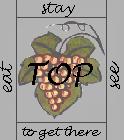 |
COGNAC - what is it? |
|
It is a white wine produced and double distilled into an eau-de-vie. About 90% grapes used are of St.Emillion (Ugni Blanc) kind. The rest are Folle Blanche and Colombard. The grape growing, harvesting and Cognac production is accomplished in a limited and strictly controlled area of South West France. This area is characterized by chalky soil, wet winters and sunny summers and it spreads through two departments of South West France; Charente and Charente Maritime. Two small growth areas are also in the Deux Sevres and the Dordogne departments. The Cognac producing region is divided into six growths areas (crus)
Cognac is the result of blending and aging of different eau-de-vie vintages. An unblended, straight vintage Cognac is very rare and available only in small quantities. Cognac is aged in Limousin oak casks (barrels). It's aging period is between 2 to 50plus years. Once transferred out of the oak wood casks into bottles, Cognac stops aging. To prevent cognac reacting with the cork, its bottles must be stored vertically. The aging is a very delicate process of interaction between outside air and the alcohol inside of the oak wood cask. This interaction is accomplished through the porosity of the oak. During this process about three percent of Cognac evaporates; this loss is referred to as "the angels share". For example, to obtain 100 liters of Cognac aged over 10 years, you will need to produce about 135 liters of Cognac. Thus the "angels share" contributes to the price of Cognac. The age is indicated on the labels. It reflects the youngest eau-de-vie used in the Cognac blend. The age is based around the legal limits during which wine is distilled; The distillation period ends at midnight of the 31st March each year. Thus the following age indication applies: *** and V.S. (Very Special) two and half years old V.O. (Very Old), V.S.O.P. (Very Superior Old Pale), Réserve must be at least four and half years old X.O.(eXtra Old), Réserve, Extra, Hors d'Age and Napoleon six and half years or older These label designations indicate more of a taste and style of a blended Cognac.
|
|
| 01 January 2001 | Copyright © 2001 Lusina ISG, Inc. |